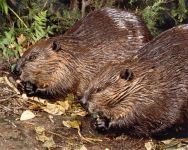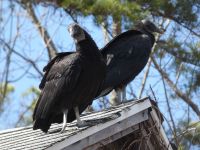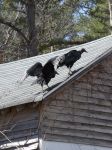Beaver Tales from Unexpected Wildlife Refuge, April 2021
Black vulture pair
Black vulture pair
Spring has arrived at the Refuge, temperatures are rising, plants are budding, and animals have become more active. In case you missed our recent social media post, the mated pair of black vultures has decided to nest again in the barn attic next to Headquarters. We are looking forward again to their activities and are hopeful for a couple of fledglings this season.
manager@unexpectedwildliferefuge.org .
Running a wildlife refuge is not only physically and emotionally demanding, there are always expenses with which to deal. Although we are frugal in how we spend Refuge funds--having only one employee and an all-volunteer Council of Trustees--we need your help in ensuring the continuation and longevity of the Refuge. We hope you will take the time to make the most generous donation you can...now . And, know that we--and the wildlife--are grateful for your continued support.
Contents of this month's newsletter:
News items
Jackie Johnson, Stacey Sperbeck
Starbucks Employee Volunteer Cleanup Event at UWR
manager@unexpectedwildliferefuge.org .
Delsea Middle School
Annual UWR Earth Day Cleanup April 25, 2021
manager@unexpectedwildliferefuge.org .
Beavers in the news
Here are some recent news media articles concerning beavers. You can see our entire list, a tribute to this wonderful keystone species, on our Beavers in the News page . If you come across a news item on beavers, please send us the link so that we can consider it for inclusion.
Beavers rescued from Scotland arrive at new home in Cornwall -- Claire Hayhurst
Rescued beaver
Two beaver sisters rescued from Scotland have reached their new home in Cornwall. The beavers were only a few months old when they were separated from their family after human intervention. No family members were found to reunite them with so they were taken into human care to ensure their survival. They were rescued by Dr Roisin Campbell-Palmer before going to Five Sisters Zoo in West Calder, West Lothian, where they underwent health screenings. The beavers have now arrived at the Cornish Seal Sanctuary, where they were released into a large woodland area.
Simple hand-built structures can help streams survive wildfires and drought -- Brianna Randall
USDA NRCS staff
Wearing waders and work gloves, three dozen employees from the U.S. Department of Agriculture’s Natural Resources Conservation Service stood at a small creek amid the dry sagebrush of southeastern Idaho. The group was eager to learn how to repair a stream the old-fashioned way.
Campaigns for animals in New Jersey
Pig farm
Take Action to Ban Gestation and Veal Crates in NJ A5236/S3401 would ban cruel gestation crates and veal crates in New Jersey and allow mother pigs and baby calves enough space to turn around freely, lie down, stand, and extend their limbs.
It is time for New Jersey to do the same.
If you live in New Jersey, contact your state senator and assemblymember, and request that they cosponsor bills A5236/S3401.
Ask Governor Murphy to Sign the Trunk Fighting Bill into Law Please contact Governor Murphy and politely urge him to sign the Trunk Fighting Bill into law :
https://nj.gov/governor/contact/
Snapshots of life at the Refuge
Northern redbelly snake
Northern redbelly snake
First-time photo op with northern redbelly snake
Mantis
Mantis egg cases
A look at the mantis life cycle
Wheel bug nest and nymphs
Wheel bug nest and nymphs
Wheel bug nests and emerging nymphs
Beaver scent mound
Beavers build scent mound to mark territory
Beloved underwing moth caterpillar
Beloved underwing moth caterpillar
Beloved underwing moth caterpillar at Miller House
Northern red-bellied turtle hatchling
Northern red-bellied turtle hatchling
Northern red-bellied turtle hatchling
Northern red-bellied turtle hatchling emerges after overwintering
Take action to help wildlife at the Refuge
As part of the vital and globally unique ecosystem that is the Pine Barrens, the Refuge is home to many endangered and threatened species. Please make a pledge to sponsor a Refuge habitat or choose to support one of the species of animals who call this protected land 'home'. You can easily do this through an automatic monthly PayPal donation (you do not need a PayPal account, just a credit card). Go to our Donate page to make your choice and subscribe. Your recurrent donations will be used, as with all our income, to continue protecting the Refuge from harm and allowing the inhabitants to live freely.
Wetland habitat: $30.00
Pine forest habitat: $25.00
Bald eagle: $20.00
Beaver kit: $15.00
Muddy Bog
Bald eagle
Beaver
River otter: $15.00
Eastern box turtle: $15.00
Red fox: $10.00
Your personal favorite: $20.00
All habitats and animals: $60.00
River otter
Eastern box turtle
Red fox
Beaver and geese
Continuing reminder about helping us help wildlife today The Refuge depends entirely on the support of our donors for our day-to-day expenses! We know that you have limited resources and need to consider which of numerous worthwhile causes to support. We hope, however, that you can again find it possible to give us a donation--today --of any amount. We and the wildlife need your support now .
Take action to help animals everywhere
Here are a few of the current issues where animals can benefit from your help. We urge you to take action and share with others.
We are your kin, not your “things.”
“Animals Deserve Gender Pronouns, Too”
“Groups Urge Associated Press to Update Animal Pronouns” . It features an Open Letter , initiated by In Defense of Animals, urging The Associated Press to update its pronoun recommendations for nonhuman animals from “what” to “who.” For decades, the AP’s Stylebook recommendations on the use of personal pronouns for nonhuman animals have cast animals as “it,” “which,” and similar demeaning and inaccurate designations that influence media coverage and public perception.
this opinion piece saying that NPR should be on the frontlines of evolving our language about animals.
Contact Scott Simon through his show Weekend Edition Saturday :
Contact an NPR show or podcast .
Contact NPR’s Public Editor on Ethics :
Ask the Public Editor about ethics .
Emu
Contact mindbodygreen and urge them to refrain from promoting slaughtered emu parts as health and beauty aids
"humanely" killed. Oh, and "treated with respect and affection." Most importantly, it means assurance that the emu was not slaughtered only for his or her oil, processed from the thick layer of fat beneath the bird’s skin, a reserve for hard times in the emu’s native Australia where this fleet-footed, flightless, and gentle nomad evolved 90 million years ago.
www.mindbodygreen.com that in 2019 featured an article boasting the health and beauty benefits of emu oil. We encourage you to contact support@mindbodygreen.com and politely urge refraining from promoting slaughtered animal parts as health and beauty aids. When you encounter promotions of emu oil or other slaughter products, please educate and advocate for the birds. If we want our own bodies to be respected, let’s practice respect for theirs as well.
Contact us
Unexpected Wildlife Refuge
http://unexpectedwildliferefuge.org/
info@unexpectedwildliferefuge.org








